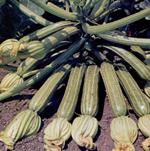| Fruits |
Vegetables
|
Courgette, Cucurbita pepo / Cucurbitaceae
|
Note: Composition for 100 g. of fresh product Values in ( min. - max. ) format. | |
| Energy: 19.00-19.00 kcal Fats: 0.40-0.40 g Fibres: 1.20-1.20 g Fat Acids Saturated: 0.10-0.10 gPolyunsat.: 0.20-0.20 g Minerals Calcium: 19.00-19.00 mgZinc: 0.20-0.20 mg Chlorine: 26.00-26.00 mg Phosporus: 36.00-36.00 mg Iron: 0.60-0.60 mg Magnesium: 17.00-17.00 mg Manganese: 0.10-0.10 mg Potasium: 210.00-210.00 mg Selenium: 1.00-1.00 µg Sodium: 1.00-1.00 mg | Proteins: 2.00-2.00 kcal Carbohidrates: 2.00-2.00 g Liposoluble Vitamins A Retinol: 0.00-0.00 µgA Carotenoids: 610.00-610.00 µg Liposoluble Vitamins B1 or Thiamine: 0.08-0.08 mgB2 or Riboflavine: 0.02-0.02 mg B3 or Niacine: 0.20-0.20 mg B5 or Pantothenic Acid: 0.11-0.11 mg B6 or Piridoxine: 0.09-0.09 mg B9 or Folic Acid: 11.00-11.00 mg C or Ascorbic Acid: 11.00-11.00 mg |

Courgette is a leafy-looking plant whose fruits are consumed when they are tender. Its masculine flowers are consumed fried when they still are in the flower bud.
Courgettes become long pumpkins in short time.
Courgettes become long pumpkins in short time.
Nutrition and eating
The most outstanding characteristic of the vegetable courgette is its great digestive power. Its continued consumption is highly recommendable to decontaminate the organism and to protect the intestinal health.
It is composed of significant amounts of carbohydrates and a low proportion of lipids and proteins. The consumption of vegetable courgettes represents a contribution of fibre.
It is composed of significant amounts of carbohydrates and a low proportion of lipids and proteins. The consumption of vegetable courgettes represents a contribution of fibre.
The fruit
 Vegetable courgettes are the unripe harvested fruits of Cucurbita pepo var. condensa (or var. melopepo).
Vegetable courgettes are the unripe harvested fruits of Cucurbita pepo var. condensa (or var. melopepo). Actually, we distinguish between courgettes and pumpkins. Vegetable courgettes are leafy-looking plants whose fruits are consumed when tender. The masculine flowers are consumed fried when they still are in the flower bud.
Courgettes become, in short time, long pumpkins.
Courgette is a quite rustic crop of fast development, reason why it is cultivated in different periods of the year in most of the Spanish regions. It is very sensitive to frosts and low temperatures, so outdoors culture is only possible once the period of possible frosts has concluded.
The optimal temperature of germination for the seed is around 20-25ºC. For the vegetative development it is between 25 and 35ºC. For blooming it requires 20ºC at night and 25ºC during the day. Below 10ºC the fruit may suffer from deformations.
It grows quite well in relative moisture around 65 and 80%. The flowering is not sensitive to the photoperiod, so there are no flowering problems due to the day length. They are produced in greenhouses at any period of the year.
The seeds have 35% of oil content. The fruit is harvested tender when the seeds have still not grown. It is basically intended for human nutrition, used in numerous dishes and cooking recipes.
The fruit has a pepo shape, that is to say, similar to cucumber. There are varieties of cylindrical and squashed shape. The most common fruits are the green-coloured, although there are also yellow or white varieties.
Its content in minerals and vitamins is very interesting, sometimes reaching 400 U.I. of vitamin A and 20 mg of vitamin C for each 100 g of fruit.
There are also baby courgettes which are harvested when they are even more tender that the normal ones.
The plant

Courgette is a crawling annual herbaceous plant. Pentagonal stem, free from thorns. The leaves have white spots within the nerves. The corolla has great lobes, lanceolate shape and yellow colour. The sepals of the female flowers have lobbed leaves. Pepo, ellipsoidal fruit, smooth or lumpy, covered with a white powder when ripe. The peduncle, of a pentagonal shape, is connected to the fruit, and the base of the stem is very developed.
| Interempresas Media, S.L. / 2026 | [ Legal notice | Política de Protección de Datos | Política de cookies | Publicidad] |
